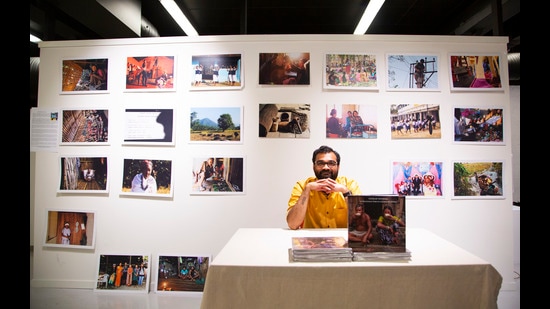The first time Abhijit AA crossed the border was with a tribal villager named Sanchita Toto. They were on a bike borrowed from someone in Totopara, a remote village in West Bengal near the border with Bhutan. They were headed to the neighbouring country to buy silver foil for a traditional necklace called a “haari” (originally made with old Indian and Bhutanese coins).
Abhijit — then a communications executive based in Mumbai, now an Oslo-based photojournalist — was in Totopara to document the lives and traditions of the Totos, one of the smallest tribal groups in the world (currently numbering 1,629 people, according to a February 2021 census conducted by the tribe for the Backward Classes Welfare Department of the Government of West Bengal). Over five years, from 2014 to 2018, he made extended trips to the village, living with tribal families as a paying guest and chronicling their lives in photographs and videos.
In April, he self-published his work as a 175-page photobook, Totos of Totopara: An Indigenous Tribe in a Globalised World. Images show traditional bamboo homes built on stilts, snapshots from rituals for birthings, cleansings, weddings and funerals.
The jewellery and sacred instruments section is riveting. There are photographs of the only surviving haari necklace and a few surviving g-malas, the necklaces of beads and stones once worn by the men of the tribe. Also, the traditional chigaimu and mugaimu drums, which resemble the dholak, remain untouched through the year and are played during festivals. Short videos are embedded in the book in the form of QR codes.

There are also images of agrarian practices, marketplaces, and transitions. This is a tribe whose young men still cross the border into Bhutan to work as daily wage labourers at construction sites and on farms. But even back then, electricity, satellite TV, cellphones and pukka houses (made of concrete and brick) were altering villages and habits.
In some ways, the change is helping. Greater access has helped the population grow from just 325 in the 1951 Census. In other ways, the erosion is alarming. Toto is on Unesco’s list of critically endangered languages. Of the tribe’s 13 clans, two consist of only one family each. A few other clans are down to two or three members.
What first drew Abhijit to this project was hearing that the tribe got its first woman graduate in 2010. “That intrigued me. What were the missing links that led to this delay?” said Abhijit, 38. “I wanted to document how younger members are now taking to technology and social media, how they are trying to balance the two eras. And I wanted to capture the traditions and way of life of this tribe before it was lost.”

A hidden world
Just getting to Totopara to ask if the tribe was willing to have their lives documented was an adventure. The nearest town, Madarihat, is 24 km away, along a treacherous path that winds across six river beds. “In the monsoon, the village becomes inaccessible,” Abhijit said.
The tribe agreed to let him in, but with riders. He wasn’t allowed into festival celebrations. The naming ceremony for newborns, called the modi-pai-powa (pronounced madi-pae-pawa), was one of few traditional rites he was allowed to witness. Another was the chai shung, a home-cleansing ritual that involves the sacrificial offerings of a chicken and a pig.
He also wasn’t allowed into the jiri, the tribe’s temple, though he was taken across the border to Bhutan to glimpse the Hispa, a mountain that is worshipped as the tribe’s most revered deity.
“Until about 25 years ago, it was forbidden to marry outside the tribe. Things are rapidly changing and Totos are marrying Bengalis and Nepalis with acceptance. But even these members are not allowed inside the jiri,” Abhijit said.
As his visits stretched into weeks and then months, Abhijit quit his job so that he could immerse himself in this rare experience. He’d earned access, but he still needed to gain the tribe’s trust. Some members remained suspicious. Why was he asking about everyday events? Why did he want to hear the same stories from different sources? Meanwhile, he still had trouble communicating directly with the tribe’s elders because they spoke only Toto. He tried to learn the language, “but it’s very difficult”, he said.
Glimpses of an endangered tribe: See more images from the book here
When his wife, software engineer Priyanka AR, joined him for a few days in 2015, that helped. “Her presence seemed to convince them I was genuine,” he said, laughing. After each visit, he would also send large prints of photographs he’d taken back to the village, “so they could see what I was doing.”
In addition to the photographs, videos and book, Abhijit comes away with priceless memories. Of a language thousands of years old and once-isolated, stretching to accommodate notes of Nepali and Bengali; of young people with Instagram accounts and elders still clad in the traditional outfit (a long coarse cloth tied at the neck and falling to the knees, secured at the waist with a cotton belt that also forms a pocket for betel nut, a small knife and other items of daily use).
Abhijit’s book is now headed to Oslo’s Fotobokfestival in August. Meanwhile, the tribe has found a new chronicler among its own.
Abhishek Toto has a YouTube channel named after himself where he posts videos of the Toto way of life. You can catch community members enjoying a picnic, celebrating a wedding, singing, cooking. Everyday activities, unfolding in a still-very-different world.
Stay connected with us on social media platform for instant update click here to join our Twitter, & Facebook
We are now on Telegram. Click here to join our channel (@TechiUpdate) and stay updated with the latest Technology headlines.
For all the latest Art-Culture News Click Here
